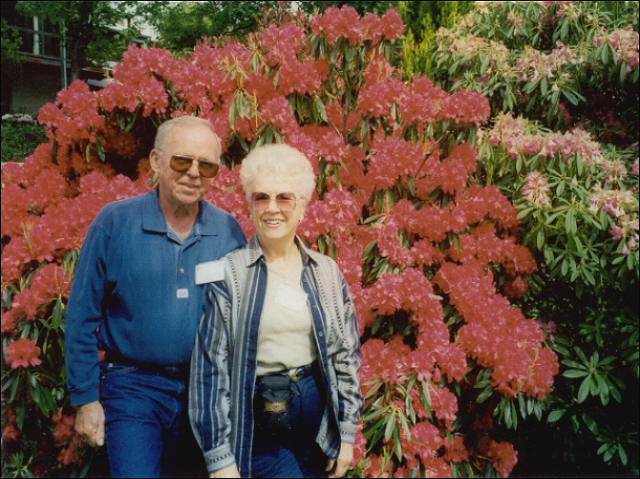Ramona and George at Walter Peak Station/farm on Lake Wakatipu across from Queenstown November 4, 1998.
Elderhostel Group Studies in New Zealand and Australia
By Ramona Bryant
I
utumn, spring, summer and winter weather...we experienced it all on the Elderhostel trip to New Zealand and Australia and in only 33 days. It was autumn when we left California on Oct. 25, 1998... springtime in New Zealand and Australia, but the over 100 degree temperature felt like summer to us, then we had winter weather when we returned to California on November 27. Being limited to one suitcase and one carry-on per person, packing for all the different types of weather and activities was really a challenge.
The flight was 12 hours 40 minutes long, but being a day ahead of us... it was Oct. 27 when we arrived in Auckland, New Zealand. Our group leader, Tom Marshall from Australia, met us at the airport and stayed with our group throughout the trip. We had a different site coordinator for the several days we were in each area and every day we had one or two lectures by very knowledgeable individuals connected with the local colleges. The lectures were either at the hotels, or while on a tour or excursion.
Lincoln University at Christchurch, New Zealand.
For example, while in the Auckland area four days, there was an introduction to New Zealand History, a Beginner's Guide to the Maori Language, the Coastline of Auckland, Living in New Zealand today, etc.
Our tours were a coach tour of the city which included a brief visit to the Auckland Museum, a full day field trip to a volcanic lake and volcanic cone, a walk on the beaches of the North Shore, a visit to Dove-Myer Robinson Park and entertainment one evening by some talented musicians.
Auckland reminded us somewhat of San Francisco with the hilly terrain, surrounding waters and considerable overcast. The Maori name for New Zealand is Aotearoa, which means "land of the long white cloud" so overcast was no surprise.From Auckland we went by coach to Rotorua. Enroute, we visited the Waitomo Glow Worm Caves formed 30 million years ago under the sea, then forced above the sea by earth movement. Once inside the cave we went by boat to the area where there are thousands of glow worms, which in their larval stage give off light to attract their food.
Our next stop was Rainbow Springs where we saw Kiwi (nocturnal flightless birds). By the way, the New Zealanders are referred to as "Kiwis." The next stop was at the Maori Arts and Crafts Institute and Whakarewarewa Thermal Area.
It's the Maori customary greeting to rub noses so that is how we were instructed to greet our Maori guide.
While staying in Rotorua, we also had a field trip to Waimangu Valley Geothermal Site, an area of diverse and intense hydrothermal activity that contains two of the largest hot springs in the world. An evening was spent at Te Tawa Ngahere Pa, a recreated Maori village owned by a Maori tourism company which started in 1990 by raising money from the sale of a Harley Davidson Motorcycle. There was instruction on Maori protocol, the traditional challenge, welcome, chants, games, weaponry demonstrations, war dances, action songs, poi dances, brief speeches and a concert, followed by food cooked in the earth oven.
Akaroa Harbor near Christchurch.
November 2 brought us to Queenstown on the shores of Lake Wakatipu in the Southern Alps of the South Island, which is very picturesque. Highlights here included a gondola ride to the Skyline Restaurant overlooking the entire Wakatipu Basin, wine-tasting and lunch at Gibbston Valley Winery, tours on Coronet Peak, to the mining area of Arrowtown and the Kawarau Bridge built in 1880, which is said to be the first bungee jumping site in the world. Anyone over 60 could jump for free, but there were no takers from our group. However, we did get to watch a brave (or crazy) man from Austria take advantage of the offer.
Rhododendrons in Arrowtown near Queenstown, New Zealand.
We also took a cruise on the coal-fired 1912 vintage steamer TSS Earnslaw on Lake Wakatipu to the Walter Peak Station (farm) where we had a farm tour, watched a sheep dog do his job, then had a buffet lunch at the beautiful home/restaurant at this picture-book location.
A resident at Walter Peak Station farm.
Next it was off to Te Anau, then a day-long coach trip and cruise aboard the Milford Wanderer in the beautiful Milford Sound to the Tasman Sea. The next day we had another coach trip to Invercargill with a short walk along the way on the Kepler Track, which was the one place it really rained on us. No surprise though, as it was a rain forest.
We next flew out of Invercargill to Christchurch where we stayed at the Academy Motor Lodge, owned by a German couple, who invited all of us into their living quarters the first evening for a reception. A highlight in the Christchurch area was a lecture and field trip to Akaroa and the Banks Peninsula, learning about family farm ownership and watched the sheering of a sheep. There are millions of sheep in New Zealand and we saw a large number of them grazing in the pastures along the beautiful countryside. Deer are also raised, and numerous herds are in pastures in the rural areas.On our final evening at Christchurch we had a most enjoyable dinner at Lincoln University. The next day (Nov. 8) we visited the International Antarctic Centre where one can get as close as is possible to the sites and sounds of Antartica without visiting it. The Centre is adjacent to the Christchurch International Airport, so after our tour and lunch, it was off on another flight with a farewell to New Zealand and g'day Australia!
Checking out an igloo at the Antarctic Center.
Part II Out and Back, Australia





